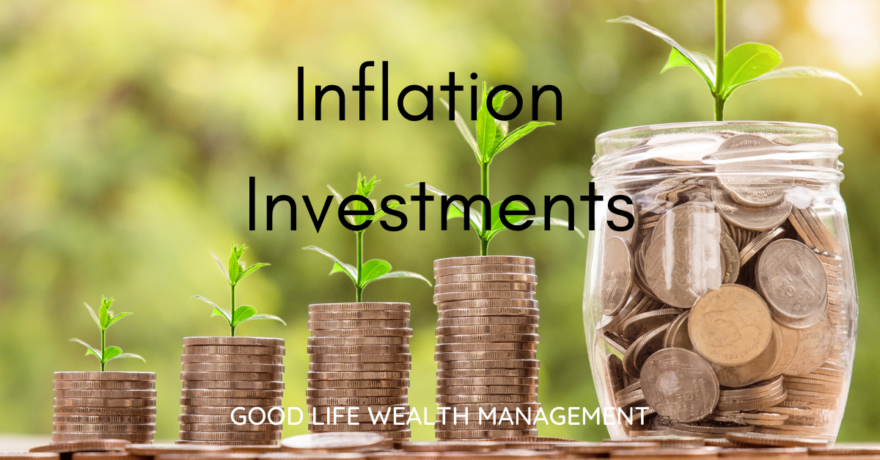With the cost of living on the rise in 2021, many investors are asking about inflation investments. What is a good way to position your portfolio to grow and maintain its purchasing power? Where should we be positioned for 2022 if higher inflation is going to stick around?
Inflation was 5.4% for the 12 months ending in July. I share these concerns and we are going to discuss several inflation investments below. Before we do, I have to begin with a caveat. We should be cautious about placing a lot of weight in forecasts. Whether we look at predictions of stock market returns, interest rates, or inflation, these are often quite inaccurate. Market timing decisions based on these forecasts seldom add any value in hindsight.
What we do know for sure is that cash will lose its purchasing power. With interest rates near zero on most money market funds and bank accounts, it is a frustrating time to be a conservative investor. We like to consider the Real Yield – the yield minus inflation. It would be good if bonds were giving us a positive Real Yield. Today, however, the Real Yield on a 10-year Treasury bond is negative 4%. This may be the most unattractive Real Yield we have ever seen in US fixed income.
Let’s look at inflation’s impact on stocks and bonds and then discuss three alternatives: TIPs, Commodities, and Real Estate.
Inflation and Stocks
You may hear that inflation is bad for stocks. That is partially true. Rising inflation hurts companies’ profitability and consumers’ wallets. In the short-term, unexpected spikes in inflation seem correlated to below average performance in stocks.
However, when we look longer, stocks have done the better job of staying ahead of inflation than other assets. Over five or ten years, stocks have generally outpaced inflation by a wide margin. That’s true even in periods of higher inflation. There are always some down periods for stocks, but as an asset class, stocks typically have the best chance of beating inflation over a 20-30 year horizon as an investor or as a retiree.
We can’t discuss stocks and inflation without considering two important points.
First, if there is high inflation in the US, we expect that the Dollar will decline in value as a currency. If the Dollar weakens, this would be positive for foreign stocks or emerging market stocks. Because foreign stocks trade in other currencies, a falling dollar would boost their values for US investors. Our international holdings provide a hedge against a falling dollar.
Second, the Federal Reserve may act soon to slow inflation by raising interest rates. This would help slow the economy. However, if the Fed presses too hard on the brake pedal, they could crash the economy, the stock market, and send bond prices falling, too. In this scenario, cash at 0% could still outperform stocks and bonds for a year or longer! That’s why Wall Street has long said “Don’t fight the Fed.” The Fed’s mandate is to manage inflation and they are now having to figure out how to keep the economy growing. But not growing too much to cause inflation! This will prove more difficult as government spending and debt grows to walk this tightrope.
Inflation and Bonds
With Real Yields negative today, it may seem an unappealing time to own bonds, especially high quality bonds. Earning one percent while inflation is 5% is frustrating. The challenge is to maintain an appropriate risk tolerance across the whole portfolio.
If you have a 60/40 portfolio with 60% in stocks and 40% in bonds, should you sell your bonds? The stock market is at an all-time high right now and US growth stocks could be overvalued. So it is not a great buying opportunity to replace all your bonds with stocks today. Instead, consider your reason for owning bonds. We own bonds to offset the risk of stocks. This gives us an opportunity to have some stability and survive the next bear market. Bonds give us a chance to rebalance. So, I doubt that anyone who is 60/40 or 70/30 will want to go to 100% stocks in this environment today.
Still, I think we can add some value to fixed income holdings. Here are a couple of ways we have been addressing fixed income holdings for our clients:
- Ladder 5-year Fixed Annuities. Today’s rate is 2.75%, which is below inflation, but more than double what we can find in Treasury bonds, Municipal bonds, or CDs.
- Emerging Market Bonds. As a long-term investment, we see attractive relative yields and improving fundamentals.
- Preferred Stocks, offering an attractive yield.
TIPS
Treasury Inflation Protected Securities are US government bonds which adjust to the CPI. These should be the perfect inflation investment. TIPS were designed to offer a return of inflation plus some small amount. In the past, these may have offered CPI plus say one percent. Then if CPI is 5.4%, you would earn 6.4% for the year.
Unfortunately, in today’s low yield environment, TIPS sell at a negative yield. For example, the yield on the Vanguard short-term TIPS ETF (VTIP) is presently negative 2.24%. That means you will earn inflation minus 2.24%. Today, TIPS are guaranteed to not keep up with inflation! I suppose if you think inflation is staying higher than 5%, TIPS could still be attractive relative to owning regular short-term Treasury Bonds. But TIPS today will not actually keep up with inflation.
Instead of TIPS, individual investors should look at I-Bonds. I-Bonds are a cousin of the old-school EE US Savings Bonds. The I-series savings bonds, however, are inflation linked. I-bonds bought today will pay CPI plus 0%. Then your investment is guaranteed to keep up with inflation, unlike TIPS. A couple of things to know about I-bonds:
- You can only buy I-bonds directly from the US Treasury. We cannot hold I-Bonds in a brokerage account. There is no secondary market for I-bonds, you can only redeem at a bank or electronically.
- I-Bond purchases are limited to a maximum of $10,000 a year in electronic form and $5,000 a year as paper bonds, per person. You can buy I-bonds as a gift for minors, and the annual limits are based on the recipient, not the purchaser.
- I-bonds pay interest for 30 years. You can redeem an I-bond after 12 months. If you sell between 1 and 5 years, you lose the last three months of interest.
Commodities
Because inflation means that the cost of materials is rising, owning commodities as part of a portfolio may offer a hedge on inflation. Long-term, commodities have not performed as well as stocks, but they do have periods when they do well. While bonds are relatively stable and consistent, commodities can have a lot of volatility and risk. So, I don’t like commodities as a permanent holding in a portfolio.
The Bloomberg Commodities Index was up 22% this year through August 31. Having already had a strong performance, I don’t think that anyone buying commodities today is early to the party. That is a risk – even if we are correct about above average inflation, that does not mean we are guaranteed success by buying commodities.
Consider Gold. Gold is often thought of as a great inflation hedge and a store of value. Unfortunately, Gold has not performed well in 2021. Gold is down 4.7% year to date, even as inflation has spiked. It has underperformed broad commodities by 27%! It’s difficult to try to pick individual commodities with consistent accuracy. They are highly speculative. That’s why if you are going to invest in commodities, I would suggest a broad index fund rather than betting on a single commodity.
Real Estate
With home prices up 20% in many markets, Real Estate is certainly a popular inflation investment. And with mortgage rates at all-time lows, borrowers tend to do well when inflation ticks up. Home values grow and could even outstrip the interest rate on your mortgage, potentially. I’ve written at length about real estate and want to share a couple of my best pieces:
While I like real estate as an inflation hedge, I’d like to remind investors that the home price changes reported by the Case-Schiller Home Price Index do not reflect the return to investors. Read: Inflation and Real Estate.
Thinking about buying a rental property? Read: Should You Invest In Real Estate?
With cash at zero percent, should you pay off your mortgage? Read: Your Home Is Like A Bond
Looking at commercial Real Estate Investment Trusts, US REITs have had a strong year. The iShares US REIT ETF (IYR) is up 27% year to date, beating even the S&P 500 Index. I am concerned about the present valuations and low yields in the space. Additionally, retail, office, apartments, and senior living all face extreme challenges from the Pandemic. Many are seeing vacancies, bankrupt tenants, and people relocating away from urban development. Many businesses are rethinking their office needs as work-from-home seems here to stay. Even if we do see higher inflation moving forward, I’m not sure I want to chase REITs at these elevated levels.
Inflation Portfolio
Even with the possibility of higher inflation, I would caution investors against making radical changes to their portfolio. Stocks will continue to be the inflation investment that should offer the best chance at crushing inflation over the long-term. Include foreign stocks to add a hedge because US inflation suggests the Dollar will fall over time. Bonds are primarily to offset the risk of stocks and provide portfolio defense. We will make a few tweaks to try to reduce the impact of inflation on fixed income, but I would remind investors to avoid chasing high yield.
As satellite positions to core stock and bond holdings, we’ve looked at TIPS, Commodities, and Real Estate. Each has Pros and Cons as inflation investments. At this point, the simple fear of inflation has caused some of these investments to already have significant moves. We will continue to evaluate the inflation situation and analyze how we position our investment holdings. Our focus remains fixed on helping clients achieve their goals through prudent investment strategies and smart financial planning.





